The Greco-Persian Wars, often known as the Persian Wars, lasted for almost half a century and were fought between Greek states and Persia. Persia launched two invasions against mainland Greece between 490 and 479, which saw the toughest match. Although the Persian Empire was at its peak, the Greek collective defense apparently defeated impossible odds and even liberated Greek city-states on the outskirts of Persia. Moreover, the Greek victory ensured the continuation of Greek culture and political systems long after the fall of the Persian Empire.
Athens rose to become the leader of the Delian League during the Persian Wars. The Persian Wars (499-449 BC) took place between the Achaemenid Empire and the Hellenic world during the classical Greek period. The battle brought Athens to power and ushered in the golden age.
The beginning of the conflict
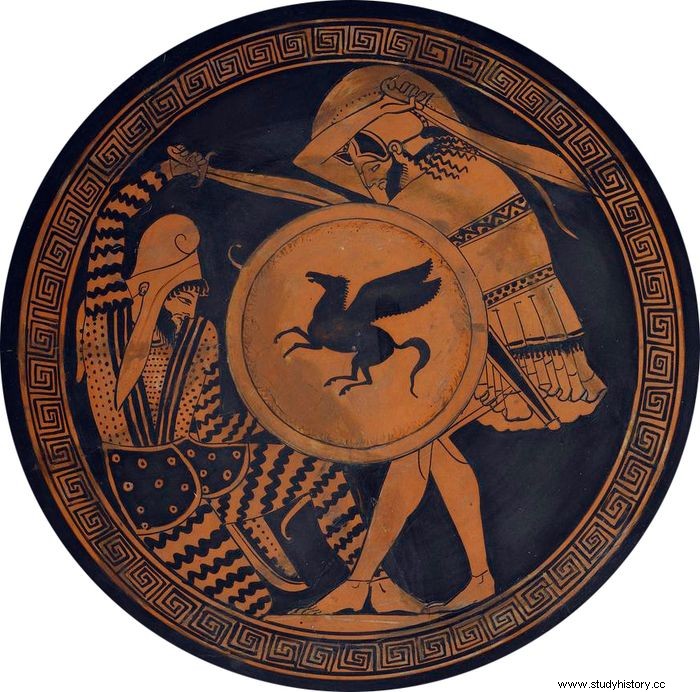
According to the Greeks of the classical period, historians generally agree that many Greek tribes moved and settled in Asia Minor after the fall of Mycenaean civilization. The Aeolians, Dorians and Ions were three tribal groups represented among the settlers.
The Ionians settled around the coast of Lydia and Caria, founding 12 cities that were politically different from each other, but still had the same cultural heritage. It served as the basis for a prestigious Ionian "cultural league". The Lydians in western Asia Minor seized the cities of Ionia, setting the territory in conflict with the Median Empire, which was the forerunner of the Akemenid Empire to the Persian Wars and a power that the Lydians despised.
The Persian prince Cyrus started a victorious uprising against the last median monarch Astyages in 553–550 BCE, and established the Achaemenid Empire. The legendary Lydian king Croesus saw an opportunity in turmoil and asked the oracle at Delphi if he should invade the Persians to expand their territory. "If Croesus were to cross Halys [the river], he would destroy an enormous empire," Herodotus claims to have received an ambiguous answer. Nevertheless, Croesus chose to attack and destroy his empire, while Lydia fell to Prince Cyrus.
The Ionians fought the Persians militarily for a period to protect their autonomy under the Persians. It was the same thing that happened under the Lydians. However, they were not offered preferential terms because they had refused to rise up against the Lydians in previous confrontations. The Persians put dictators in every city as a control measure because the Ions were difficult to command.
The Ionic Uprising
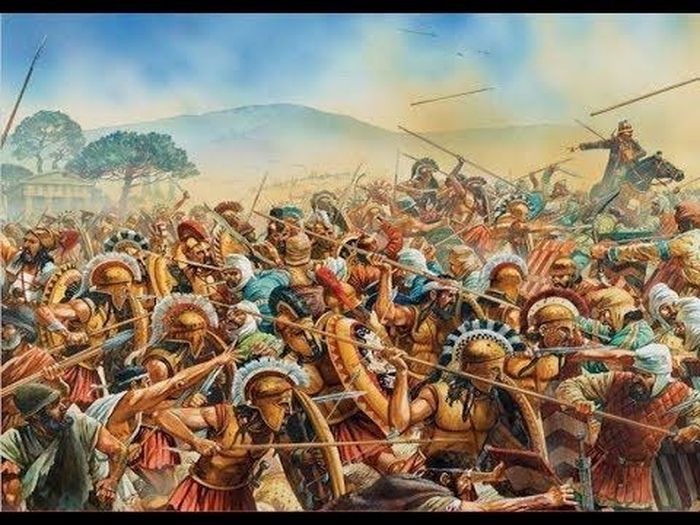
The Ionian uprising took place in 499 BCE when Greeks in the region rebelled against Persian control. Deep dissatisfaction with the tyrants appointed by the Persians to control the local Greek communities was the root of the uprising. Aristagoras, a Milesian dictator, started the uprising. After an unsuccessful attempt to take Naxos, the Greeks used dissatisfaction with the Persian monarch Darius the Great to his political advantage.
Athens and other Greek cities offered aid, but were forced to withdraw after losing the Battle of Lade in 494 BCE As a result, Persia regained control of Asia Minor. The Ionian Revolt is the first major battle between Greece and the Persian Empire. This is the beginning of the Persian Wars. Darius promised to avenge Athens and developed a strategy to conquer all Greeks in order to maintain the integrity of his empire.
The support of dictators from Persia and demands for tribute and service caused dissatisfaction in the Greek states of Asia Minor. Two unscrupulous tyrants exploited this policy. Miletus' tyrant, Histiaeus, had been imprisoned in Susa. Aristagoras, his son-in-law and his deputy at Miletus, had supported the Persian invasion of Naxos. When the invasion failed, Histiaeus and Aristagoras planned to revolt against the Greek states in Asia Minor, for fear of Persian retaliation. At Miletus, Aristagoras established a constitutional government, and tyrants were expelled from the other states.
Aristagoras sailed to Greece in need of help during the winter. The Spartans refused to send troops because they recognized their limitations as a land force, but the Athenians promised 20 triremes and the Eretrians 5 triremes. When these ships arrived in 498, the Ionians immediately began seizing and burning the majority of Sardis, the capital of satrapia. This victory sparked uprisings in the Greek states of Bosphorus and Hellespont, Caria and Greek cities in Cyprus. The Athenians withdrew their ships at this time, and the heretics most likely followed.
Ongoing riots
The rebels needed to launch a maritime operation to secure Cyprus and confine the Phoenician navy to the southern Mediterranean. However, the Persians were quick to recognize the value of Cyprus. With the help of a Phoenician fleet, an army group landed north of the island and attacked Salamis on land and sea. The Ions defeated the Phoenician fleet, but the Persian army overthrew the Cypriot Greeks. In 496, the last Greek fortress on the island surrendered.
Meanwhile, the Bosphorus and Hellespont were recaptured by two Persian army groups. They started a last campaign in 495, although they were delayed by a defeat at the hands of the men in 496. While the Persian army defended the coast near Miletus, a large fleet of Egyptians, Phoenicians and Cypriots moved to army-controlled ports. It engaged the Ionian fleet of 353 triremes around the island of Lade off the coast of Miletus. At sea, the Persian triumph was significant. In 494 Miletus fell, and the revolt was put down in 493.
The Ionian uprising was extremely favorable to the Greek cause. It delayed the Persian invasion of Greece until the Greek mainland nations were able to unite, undermined Persian confidence and taught the Greeks some critical lessons. Individually, the Greeks had defeated the Persians on land and at sea, so resistance did not seem useless. But close cooperation and strong leadership are crucial in the future.
The Ionians had created a council of deputies drawn from the several states and entrusted it with strategic leadership. Nevertheless, they had not managed to include the Greeks from the Bosphorus, Hellespont and Cyprus in the council. They also failed to name a commander-in-chief of the Allied forces before the night before the battle of Lade, when it was too late.
Greece's first Persian invasion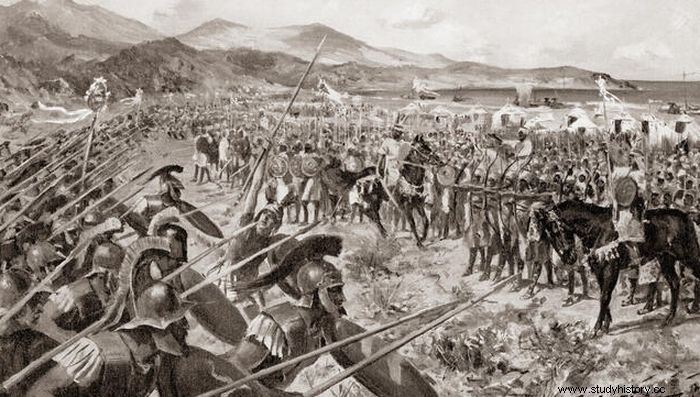
Mardonius, a Persian general, started an expedition over Thrace and Macedonia in 492 BCE During this expedition, Mardonius again subjugated Thrace and forced Macedonia to become a completely obedient client of the Persian Empire, even though they had previously had some degree of autonomy.
Despite the victory, he was injured and had to retire to Asia Minor. A storm that occurred off the coast of Athos also cost him his 1,200-ship navy. With the exception of Athens and Sparta, which both assassinated their respective embassies, Darius sent ambassadors to all Greek cities. It would require complete submission in light of the recent Persian triumph. However, Sparta was drawn into the conflict due to Athens' continued defiance.
About 100,000 490 Persians landed in Attica in 9,000 BCE to conquer Athens. Nevertheless, they were destroyed in the battle of Marathon by a Greek army. The army has 1,000 Athenian hoplites and XNUMX plane trees led by Miltiades, an Athenian general. The Persian Navy continued to cruise to Athens, but chose not to attack because it was garrisoned. The Battle of Marathon was the decisive turning point in the Persian Wars because it showed that the Greeks defeated the Persians. It also highlighted the superiority of the Greek hoplites, who were more heavily armed.
Postbellum (490–480 BC)
After the first Persian invasion failed, Darius gathered a massive army to attack Greece again. However, Darius' Egyptian subjects revolted in 486 BCE, delaying any pressure into Greece. As he prepared to march on Egypt, Darius died, and his son, Xerxes I, ascended the throne. Xerxes quickly destroyed the Egyptians and resumed their plans to invade Greece.
Greece's second invasion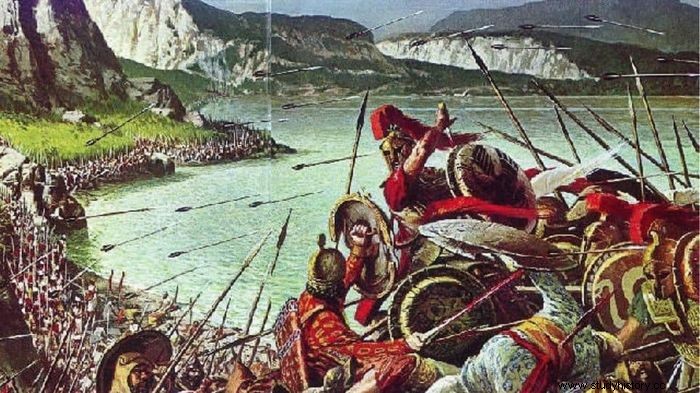
Xerxes sent a far greater force of 300,000 480 soldiers over a double pontoon bridge over the Hellespont in 1,207 BCE, with XNUMX ships in support. As the Persian fleet marched along the coast and resupplied the ground forces, this army conquered Thrace before going down to Thessaly and Boethia. Meanwhile, the Greek navy rushed to block Cape Artemision.
So, after being held back in the Thermopylae conflict by Leonidas I, the Spartan monarch of the Agiad dynasty (a struggle remarkable due to the extreme imbalance of troops, with 300 Spartans facing the entire Persian army), Xerxes pushed in. in Attica, and captured and burned Athens. . However, the Athenians had left the city via water and destroyed the Persian navy at the Battle of Salamis, led by Themistocles.
An ore of silver ore was discovered in Laurion (a small mountain range near Athens) in 483 BCE, during the peacetime between the two Persian invasions. The ore mined there paid for the construction of 200 wars to combat piracy from the selfish. The Greeks, led by Spartan Pausanias, defeated the Persian army at Plataea a year later.
Meanwhile, at the Battle of Mycale, the Allied Greek navy defeated the Persian navy, paralyzed Xerxes naval force and established the dominance of the Greek navy. The Persians began to withdraw from Greece after the battles of Plataea and Mycale and never attempted a new invasion.
Greek Retribution
The Battle of Mycale was a watershed for the Greeks, who then attacked the Persian fleet. The Athenian fleet then moved to pursue the Persians out of the Aegean Sea, eventually capturing Byzantium in 478 BCE In the process, Athens recruited all the island nations and several mainland states of the Delian League, whose goal was to continue fighting the Persian Empire, prepare for future invasions and create a mechanism to share the spoils of war.
Despite their participation in the war, the Spartans withdrew in isolation afterwards. The liberation of mainland Greece and the Greek cities of Asia Minor, the Spartans believed, had already achieved the objectives of the war. According to historians, Sparta was similarly skeptical of the Delian League's potential to provide long-term security for Asian Greeks. With the removal of Sparta from the league, Athens was able to build unsurpassed naval and commercial strength in the Hellenic world.
The Aftermath of the Persian War
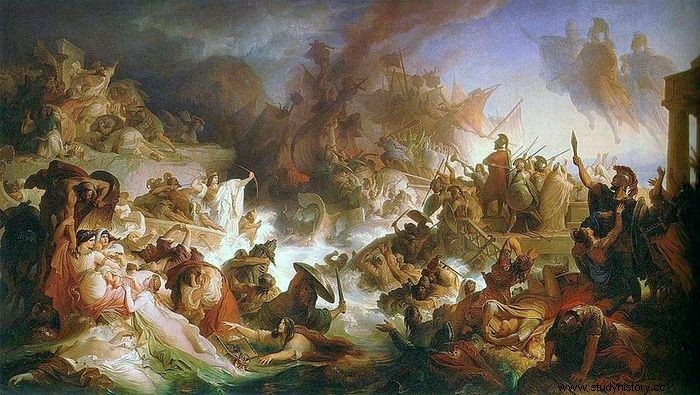
Despite their successes in the Persian Wars, the Greek city-states emerged more divided than united from the struggle.
The Aftermath of the Persian Wars
The combined Greek victory destroyed a significant part of the Persian fleet and the expulsion of all Persian garrisons from Europe, thus ending Persia's advance west into Europe. Ionian cities were also liberated from Persian rule. Despite their victories, the booty provoked several internal strife in the Hellenic Empire. For example, Pausanias' aggressive actions during the siege of Byzantium alienated many Greek nations from Sparta, which led to the military authority of the Delian League moving from Sparta to Athens. That triggered Sparta's last exit from the Delian League.
Two divisions
After the two Persian invasions of Greece and during the Greek counter-attacks that began after the battles of Plataea and Mycale, Athens formed the Delian League, which aimed to pursue battle with the Persian Empire, prepare for future invasions and distribute the spoils of battle. Despite their participation in the war, the Spartans left the Delian League early, claiming that the original goals of the war were achieved with the independence of mainland Greece and Greek cities in Asia Minor.
Historians also claim that Sparta left the league for pragmatic reasons, believing that long-term security for Greeks in Asia Minor was unsecured due to their dissatisfaction with Athenian ambitions to expand its influence. Sparta was once a powerful city-state.
After withdrawing from the Delian League after the Persian Wars, it reconstituted the Peloponnesian League, founded in the 6th century and served as a model for the Delian League. The removal of Sparta from the league, on the other hand, allowed Athens to develop unique naval and commercial strength throughout the Hellenic world. Athens began using the league's navy for its own purposes shortly after the league's founding, which often led to conflict with other, less powerful league members.
Delian League Rebellion
A series of riots broke out between Athens and the league's smaller city-states. In 471 BCE, for example, Naxos tried to break away from the league for the first time. It was eventually defeated and forced to tear down its defensive city walls, lose its fleet and lose its voting rights in the league.
Another league member, Thasos, deserted after Athens established the colony of Amphipolis on the Strymon River in 465 BCE, threatening Thasos' interests in the Mt Pangaion mines. Thasos allied with Persia and asked Sparta for help, but Sparta could not help due to the largest helotrevolution in history.
Nevertheless, circumstances strained relations between Athens and Sparta. Eventually, Thasos was recaptured, and it returned to the Delian League after a three-year siege. This was despite the fact that they lost their defensive walls and fleet, had their mines over to Athens and paid annual tributes and fines. The siege of Thasos, according to Thucydides, signaled the league's transition from an alliance to a hegemony.
the conclusion
The Persians developed a part-and-rule approach after defeating the Greeks and being plagued by internal revolts that hampered their ability to fight external invaders. In 449 BCE, the Persians sought to inflame tensions between Athens and Sparta by bribing politicians to achieve their goals. They planned to keep the Greeks busy with internal strife to prevent a wave of counterattacks from reaching the Persian Empire. Their approach was most effective, and the Greeks and Persians did not take part in open warfare until 396 BCE when the Spartan ruler Agesilaus invaded Asia Minor for a brief period.
